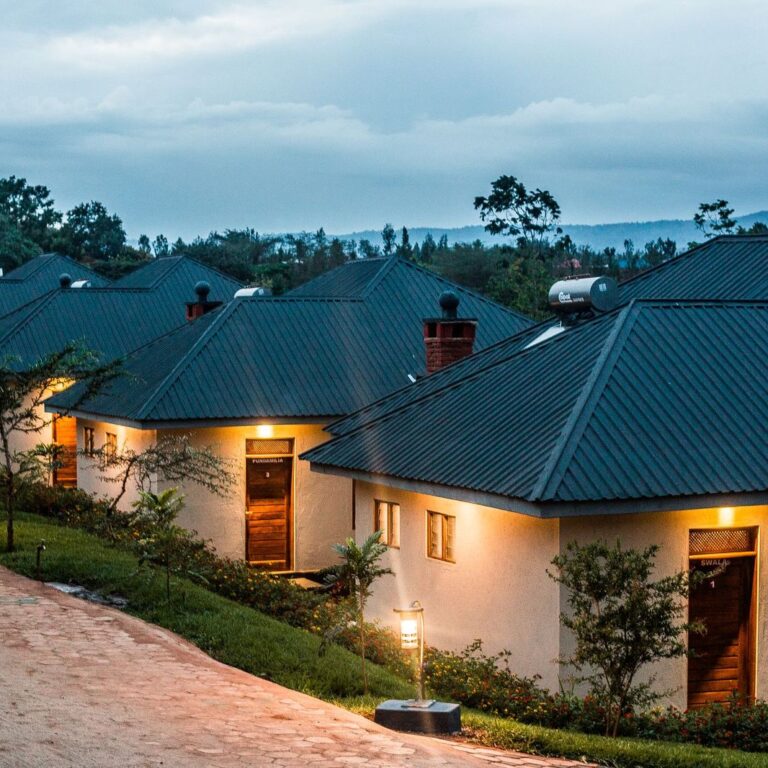What Plants and Trees Will I See on Mount Kilimanjaro?
Mount Kilimanjaro, standing majestically as Africa’s highest peak, isn’t just a haven for adventure seekers; it’s also a treasure trove of botanical wonders What Plants and Trees Will I See on Mount Kilimanjaro?. In this expedition through flora, we delve deep into the captivating world of plants and trees that adorn the slopes of Kilimanjaro. From the lush rainforest belt to the alpine desert, each elevation zone hosts its unique array of vegetation, promising an enriching experience for every nature enthusiast.
Climbing through the five ecosystems of Mount Kilimanjaro rewards trekkers with a visual display of brilliant and unique plant life. There are flowers, plants, and trees that you can find in no other part of the world but here. Let me introduce you to some of the fascinating flora you’ll encounter on your journey:
1. Lobelia Deckenii: Towering Beauties of the Alpine Zone
Lobelia deckenii, commonly known as giant lobelia, is an iconic sight in the alpine zone of Mount Kilimanjaro. These towering plants, with their elongated, spiky leaves and vibrant clusters of flowers, dominate the landscape as you approach the summit. Endemic to the mountain, Lobelia deckenii has evolved to withstand extreme temperatures and low oxygen levels, thriving in the rocky, volcanic soil.
- Characteristics
The striking appearance of Lobelia deckenii is matched by its impressive size, with some specimens reaching heights of over 10 feet. This giant lobelia is found only in the high mountains of East Africa, between 12,000 to 15,000 feet. Their trumpet-shaped flowers, ranging in color from deep purple to electric blue, attract pollinators such as sunbirds and bees, adding bursts of color to the stark alpine terrain. Despite their delicate appearance, these hardy plants have adapted to survive in the harsh conditions near the summit, where temperatures can plummet below freezing.
2. Dendrosenecio Kilimanjari: The Senecio Forests
Dendrosenecio kilimanjari, also known as the Kilimanjaro giant groundsels, are another iconic feature of the mountain’s alpine zone. These peculiar-looking plants, resembling oversized cabbages on long stems, form dense forests known as senecio zones. Found exclusively on Mount Kilimanjaro and its close peaks.
Dendrosenecio kilimanjari is a distinctive plant species native to Kilimanjaro’s iconic mountain slopes. It grows up to 10 m (32 f) tall, with thick, upright stems and a crown of sturdy green leaves at the top
- Adaptations
Despite their resemblance to trees, Dendrosenecio kilimanjari are actually giant herbaceous plants, capable of reaching heights of up to 16 feet. Their thick, succulent leaves help them retain water in the arid alpine environment, while their woody stems provide structural support against strong winds. These unique adaptations allow Dendrosenecio kilimanjari to thrive in the harsh conditions near the summit, where few other plants can survive.
Another unique plant, Dendrosenecio kilimanjari, inhabits the middle altitudes on the Shira Plateau and around Barranco Camp. Slow-growing but impressive, it can reach a height of 20 feet. The old dead leaves fold over the trunk to provide insulation, and the stem’s pith stores water. Like Lobelia deckenii, its leaves close when it gets cold to keep frosty air out
3. Everlasting Flowers: Beauty in Resilience
Everlasting flowers, belonging to the Helichrysum genus, are a common sight in the subalpine and alpine zones of Mount Kilimanjaro. These hardy plants, known for their vibrant yellow flowers and silvery foliage, add a splash of color to the rocky slopes and grasslands. Despite their delicate appearance, everlasting flowers are incredibly resilient, capable of surviving droughts, frost, and high winds.
These flowers are very common on Kilimanjaro at elevations between 8,000 to 15,000 feet. The herbaceous perennial grows in clumps and can reach almost two feet tall. Its yellowish-brown shade, lemon-scented leaves, and unique structure help it survive the dry and frosty climate of the mountain
- Uses of Everlasting Flowers
Ornamental value, everlasting flowers have long been used for medicinal and ceremonial purposes by the indigenous people of East Africa. Dried flowers and leaves are often brewed into teas or used as aromatic additives in traditional healing practices. Their ability to thrive in harsh environments has also led to ongoing research into their potential pharmaceutical properties.
4. Protea Kilimandscharica: A Symbol of Endurance
Protea kilimandscharica, commonly known as the Kilimanjaro protea, is a striking shrub found in the montane and subalpine zones of Mount Kilimanjaro. Its large, cone-shaped flower heads and leathery leaves, this resilient plant is well-adapted to the mountain’s rocky slopes and volcanic soils. Endemic to the Eastern Arc Mountains of Tanzania, Protea kilimandscharica is a symbol of endurance in the face of adversity.
- Conservation: Protea Kilimandscharica
Despite its adaptability, Protea kilimandscharica faces threats from habitat loss and climate change, particularly in the lower elevations of its range. Conservation efforts are underway to protect the remaining populations of this iconic species. Including the establishment of protected areas and the propagation of nursery-grown specimens for reforestation projects.
5. Stoebe Kilimandscharica: A Study in Adaptation
Stoebe kilimandscharica, also known as Kilimanjaro everlasting. A small shrub found in the montane and subalpine zones of Mount Kilimanjaro. With thick, waxy leaves that help reduce water loss and protect against frost.
A genus of African plants in the daisy family, stoebe shrubs have slender. Wiry branches covered with small leaves pressed to the stem. Their flowerheads are located at the ends of the main shoots. Stoebes are hardy and even invasive plants that are extremely difficult to eradicate.
- Endemism: Stoebe Kilimandscharica
Endemic to the Eastern Arc Mountains of Tanzania, Stoebe kilimandscharica is found nowhere else in the world. Its restricted range makes it vulnerable to habitat destruction and climate change. Underscoring the importance of conservation efforts to preserve this unique species for future generations.
6. Red Hot Poker: A Splash of Color
Red hot poker, or Kniphofia uvaria, is a striking perennial plant native to South Africa. Despite its origins, it has naturalized in many regions around the world. What Plants Grow on Kilimanjaro? Including the montane and subalpine zones of Mount Kilimanjaro. Known for its tall spikes of tubular flowers in shades of red. Orange, and yellow, red hot poker adds a vibrant splash of color to the mountain’s rocky slopes and grasslands.
Showy and dramatic, red hot poker plants belong to the liliaceae family. These drought and heat-tolerant perennials flourish in the arid areas of Mount Kilimanjaro.
- Ecological Impact: Red Hot Poker
While red hot poker is prized for its ornamental value in gardens and landscapes. It can also have ecological impacts when introduced into new environments. In some regions, it has become invasive, outcompeting native vegetation and altering local ecosystems. As such, it’s important to plant responsibly and avoid introducing non-native species into fragile ecosystems like those found on Mount Kilimanjaro.
7. Old Man’s Beard: A Furry Enigma
Old man’s beard, or Usnea, is a genus of lichen found in abundance throughout the montane and subalpine zones of Mount Kilimanjaro. Which Unique Plants You Will Find During Your Kilimanjaro Hike?Named for its resemblance to a long, gray beard. This peculiar organism is actually a symbiotic association between algae and fungi. Hanging in festoons from tree branches and rocky outcrops. Old man’s beard adds an ethereal quality to the mountain’s mist-shrouded forests.
- Medicinal Uses: Old Mans Beard
Used for medicinal purposes by indigenous cultures around the world. Rich in antibacterial and anti-inflammatory compounds. The Plant Life of Kilimanjaro | World Adventurers. Used to treat a variety of ailments, from sore throats to skin infections. However, overharvesting and habitat loss threaten populations of this valuable resource, highlighting the need for sustainable management practices.
8. Dentata: The Toothed Wonder
Dentata, also known as Lobelia gibberoa, is a species of lobelia found in the montane and subalpine zones of Mount Kilimanjaro. Kilimanjaro Plant Life – From Summit To Base. Named for its toothed leaves, which resemble a row of serrated teeth. Dentata is a common sight along the mountain’s streams and waterfalls. Despite its diminutive size, this hardy plant plays a crucial role in stabilizing soil and preventing erosion in the fragile alpine ecosystem.
- Habitat: Dentata
Dentata thrives in moist, rocky habitats, where it forms dense mats of foliage along the banks of mountain streams. What Plants and Trees Will I See on Mount Kilimanjaro? Its vibrant blue flowers attract pollinators such as bees and butterflies, adding bursts of color to the verdant landscape. While dentata is not endemic to Mount Kilimanjaro, it is an important component of the mountain’s rich biodiversity.
9. Tussock: Guardians of the Alpine Grasslands
Tussock grass, or Festuca kilimanjarica, is a native grass species found in the alpine zone of Mount Kilimanjaro. Forming dense clumps or tussocks. What Plants and Trees Will I See on Mount Kilimanjaro? This hardy grass plays a vital role in stabilizing soil and preventing erosion in the harsh alpine environment. Despite its humble appearance, tussock grass supports a diverse array of wildlife. Providing food and habitat for insects, small mammals, and birds.
Adaptations: Tussock
Where temperatures can drop dramatically and winds can reach hurricane force. What Plants and Trees Will I See on Mount Kilimanjaro?. Its deep root system helps it access water deep below the surface. While its dense foliage provides shelter for alpine flora and fauna. What Plants and Trees Are Found on Mount Kilimanjaro? As a keystone species in the alpine ecosystem. Tussock grass is essential for maintaining the delicate balance of life on the mountain.
10. Fireball Lily: A Fiery Delight
Fireball lily, or Scadoxus multiflorus, is a striking bulbous plant found in the montane and subalpine zones of Mount Kilimanjaro. Known for its large spherical flower heads in shades of fiery red and orange. Fireball lily adds a splash of color to the forest understory.
- Symbolism: Fireball Lily
In addition to its ornamental value, fireball lily holds cultural significance in many African societies. However, its popularity in horticulture has led to overharvesting in some regions, threatening wild populations of this iconic species.
What is unique about the giant groundsel?
Giant Groundsel – The Most Unique Plant on Mount Kilimanjaro. The Giant Groundsel’s physical appearance is striking. It has a long, stout, woody stem topped with a large rosette of leaves. This unique structure is not just for show, but the result of adaptations to the harsh mountain environment.
Conclusion: What Plants and Trees Will I See on Mount Kilimanjaro?
As you embark on your journey to the summit of Mount Kilimanjaro. Take time to appreciate the remarkable diversity of plant life that calls this iconic mountain home. Mount Kilimanjaro Plants and Trees. From towering lobelias to delicate everlasting flowers, each species has adapted to thrive in the harsh conditions of high altitude. Creating a tapestry of color and life amidst the rocky slopes and barren deserts. By discover the flora of Mount Kilimanjaro. You’ll gain a deeper understanding of the interconnectedness of all life on Earth and the importance of protecting our planet’s fragile ecosystems.







